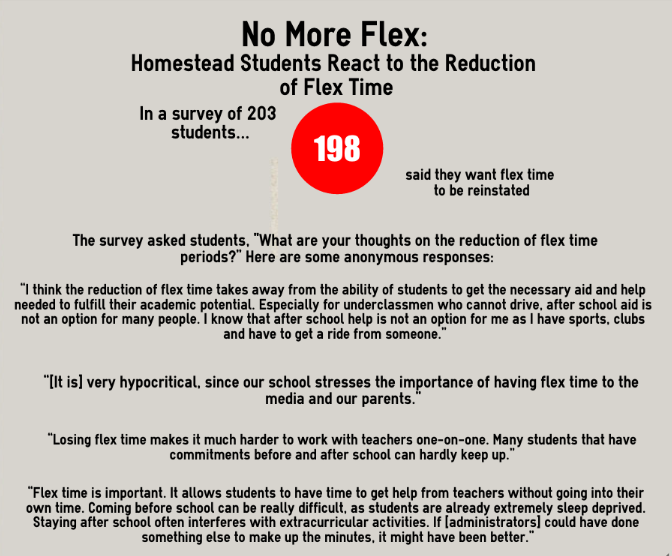Less flex, more stress: Flex time reduction causes difficulties for students

On Monday Jan. 25, Principal Mr. Brett Bowers sent an email memo to parents of all Homestead students stating that flex time would be limited to only the final two weeks of the second and third trimesters, these dates being Feb. 23, Feb. 25, March 1, March 3, May 26, May 31, June 2 and June 7. These flex times were placed before exam weeks to ensure that students will have adequate time to ask their teachers any questions before the exam.
According to the email, the reduction of flex time is due to “the cancellation of classes on Friday, Jan. 22, coupled with the shortened day in November to accommodate the Division 2 State Football Championship.”
The Wisconsin Department of Public Instruction (DPI) requires that high schools have 1,137 instructional hours per year. At the beginning of the year, Homestead had over that minimum number of hours, providing a slight cushion. Early dismissal at 10:15 a.m. on Friday, Nov. 20 for the Division 2 State Football Championship took away a few of the cushion hours, but Homestead still met the qualification for the hours per year.
After the social media threat incident on Friday, Jan. 22 caused an unexpected cancellation of school, Homestead fell to about 1,130-1,131 hours, which is under the minimum number of hours required every year.
The administrators looked at the options available to make up for the lost hours and decided that “there was no good option, but scaling back flex time was the best of the bad options,” Principal Bowers said.
Other options discussed to replace the lost hours were taking away Friday, Feb. 12, the day that is given off for mid-winter break, or taking away Thursday, March 10, which is the day after second trimester exams.
The issue with only the high school having school on Feb. 12 is that “families have planned that older sibling can provide childcare for K-8, and then we would be springing this on them with relatively little notice,” Principal Bowers said. There are also a lot of families who have planned to be out of town that week, and if there ends up being school that day, then conflicts may arise.
According to administration, having school on the day after exams would be incredibly difficult for both students and teachers. For students, that day is a rest day to recover after a stressful week of exams, and for teachers, it would be nearly impossible to grade all of the exams and plan a lesson for a whole new trimester of classes.
“There is no good option in my opinion, but it seems that the reduction of flex is the best of bad choices. If there was a win-win then we definitely would have taken it, but we just don’t have a win-win,” Principal Bowers said.
Despite administration’s view that eliminating flex is the best option, many students are, nevertheless, upset. In a survey of 203 Homestead students, 198 said that they wished to have flex time back.
“I am highly irritated with the fact that flex is no longer an option to talk with teachers or have extra free time before extracurricular activities. I moved here sophomore year and I feel like every year I’ve been here this ends up happening; we might as well not even have flex time to begin with,” Christianna Gess, senior, said.
Five students said that they were fine without flex time, stating their main reason as no longer being flex mandatory. One student said, “I’m fine with the reduction of [flex time] because I was mandatory, and the fact I would be punished by something that’s meant to help me is a bit wrong in my mind.”
Although there truly is no win-win situation, I believe a good option would be to make flex time mandatory for everyone. Although some students feel anger towards being flex mandatory, they must now stay in school for the extra 26 minutes anyways, even without flex time. If the current schedule adjustment mandates us to be in school until 2:37 p.m. no matter what, then we should have the opportunity to stay in a class in which we could use the extra help.
An anonymous Homestead student who took the survey agrees. “[I am] disappointed. Students with extracurricular activities don’t have the time to get the extra help they need before or after school, so flex time has always been the solution for this. A better solution would be to make flex time mandatory, so that students get the help they need, and the school attains the required hours of school.”
“It is hard for me to buy into Homestead’s idea of taking a stretch class and challenging myself if there is not an easy way to get one-on-one time with the teachers for help,” Rachel Zimdars, senior, said. “As a student in four AP classes, and a member of a varsity sport, I do not have time to now stay after school to ask questions, go to practice and do my homework while also getting adequate sleep.”
The entire situation of the reduction of flex time is not ideal, and it is not the best solution to the lack of hours that need to be made up. Coming before school for help is not the answer to this problem because it would require students to wake up even earlier than they already do, and staying after school is often impossible for students with extracurricular activities, especially when making up a test or an impromptu can take over an hour after school. It is very inconvenient for both students and teachers to make special arrangements to get to school or to leave school at a different time than they are accustomed to doing. It is easy for administration to say that taking away our primary one-on-one time is the best option; however, the situation makes our lives as students, as well as the lives of teachers, much more difficult.

Cassie Shaurette is an outgoing, loud and often annoying senior. She is always stressed about the amount of work that she needs to complete. She loves...





